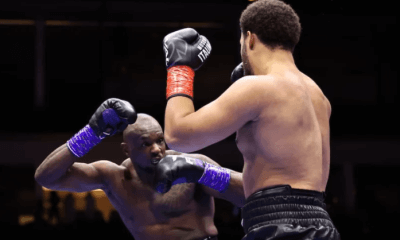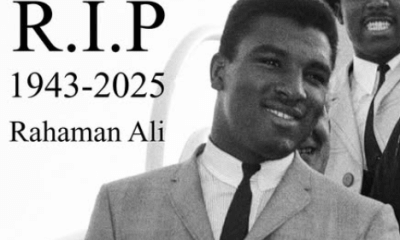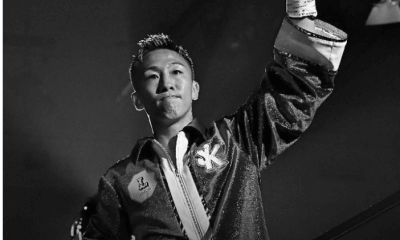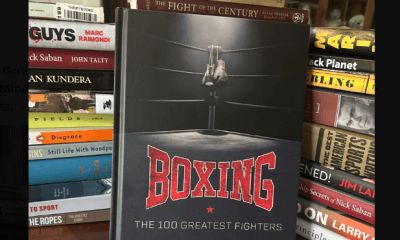Featured Articles
Moloney vs Astrolabio on Saturday has the Mark of an Old-fashioned Dust-Up

This Saturday night in the Stockton Arena in California a fascinating 118lb match will be fought between two of the world’s best bantamweights, Australia’s Jason Moloney, 25-2 and ranked two, and Filipino Vincent Astrolabio, 18-3 and ranked four.
Asrolabio’s rise has been the more meteoric. Clearly talented, it is also true that in 2021 he was very much a preliminary fighter, a supporting act for more storied Filipinos, minimumweight Rene Mark Cuarto among them. In February of 2022 however, Astrolabio got the call he had been waiting for – he was to headline a card out in Dubai, his opponent the former pound-for-pounder and two-time Olympic gold medallist Guillermo Rigondeaux. His purse, rumoured to be around $75,000, was less than a third of what Rigondeaux was set to pocket but still represented a career’s best payday. To maintain such riches, all Astrolabio had to do was win.
This he did, and in style.
Astrolabio came into the fight riding a four-fight knockout streak, a response to his loss out in China to ZongLi He. In truth, Astrolabio probably deserved the nod in that fight, a majority decision that had the smell of hometown cooking if not quite out and out theft. The lesson he learned from his eight-rounder with ZongLi though was not to neglect his body punching. Astrolabio banked early rounds hitting with a right hand to the body and it was a punch he forgot when ZongLi upped the aggression and it probably cost him. Against Rigondeaux, he would not make the same error.
Rigondeaux did his thing, made Astrolabio miss, sometimes by a lot, but the Filipino also turned in a strategic masterpiece. Patient, he also bought pressure. Careful never to throw one punch when two were there to be had, he never got greedy. His mix of touch and power was perfect. Rigondeaux kept waiting as though he expected the same old openings to present themselves, but when they did – and they did – he often found himself out of position or landing a single shot. In the eighth, Astrolabio flashed Rigondeaux with a right-handed punch, but only after repeatedly rattling him with right hands to the head throughout that round. The penny finally seemed to drop for Rigondeaux who won the ninth and tenth but by then it was too late – all three judges had the fight for Astrolabio by virtue of the knockdown (I saw it slightly wider).
His first steps with his newfound status were tentative; he boxed a rusty Nikolai Potapov (now 23-3-1) on a Frank Martin undercard. In fairness, he met the expectation of those of us who had been following his career and exceeded the expectations of many others, sending Potapov to the canvas twice in the very first round, first with a cuffing right hand above the ear and later in the round with a similar counter left. After handing out some brutal treatment in the fourth, Astrolabio found his man with hurtful uppercuts in the fifth and Potapov was down again; matters were settled in the fifth by pressure and a left hook/right uppercut combination. It is worth pointing out that Potapov had never been down as a professional and although stopped once before by long-reigning titlist Omar Narvaez in 2017, this was a corner stoppage. Against Astrolabio a rattled Potapov was sent down four times and heard the ten.
Astrolabio, now twenty-six years old, further developed his body-attack in this fight and his right uppercut is a punch that has come to fruition; furthermore, he clearly impressed an American commentary team (and perhaps audience) who were not that familiar with him – but there is a sense that despite his superb 2022 form, his final confirmation as world-class lies before him. Was Rigondeaux past it? Was Potapov hampered by inactivity? Neither one of these things can be said of Astrolabio’s next opponent.
Moloney is thirty-two, in his fistic prime and highly regarded. The route to divisional kingship lies, for him, through Emmanuel Rodriguez, the current number one and a man who bested him in 2017. This was a close fight and a frustrating one for the Australian, who finished far and away the stronger, winning the ninth through twelfth on my card, but having been cleanly out-boxed in the first half of the fight, it wasn’t enough. It underlines, though, Moloney’s greatest strength: it is unlikely that there is a better conditioned fighter on the planet.
Workrate and conditioning have been the core of what has made Moloney a success since that split loss to Rodriguez as he won eight including five by stoppage. It is true that these wins were bisected by a defeat to the mighty Naoya Inoue, the pugilistic equivalent of being struck by lightning. Still, it is worth noting that when Moloney has stepped up to a level of competition that might be considered higher than Astrolabio’s, he has lost, and that if he were to successfully best Astrolabio, it would represent his biggest, his most important victory.
Moloney spent the first years of the 2020s in the USA, building his name and being battered by Naoya, but in 2022 he returned to Australia for a pair of homecoming fights. The first was against Filipino Aston Palicte (now 28-5-1) who is in possession of neither the quality nor the patience of Astrolabio but does fight with the same sort of punching aggression. It is worth noting then that Moloney timed him on the right uppercut, a shot Astrolabio likes, with a beautiful right hand of his own from which Palicte never recovered. Moloney got him out of there in three – it had previously taken world-class veteran Kazuto Ioka ten. Moloney was heavily favoured, but this was impressive work.
More intriguing in many ways was his most recent fight against the teak-tough Thailander Nawaphon Kaikanha. Kaikanha, now in his early thirties, has boxed one of those fascinating Thai careers heavy on numbers and light on names, but for his 56-2-1 he has victories over former flyweight champion Sony Boy Jaro, and a past-prime version of the storied flyweight beltholder Amnat Ruenroeng. Stopped just once very much against his will back in 2017, Kaikanha, stalking forwards in his Muay Thai stance, was in many ways the perfect foil for Moloney to deploy his fleet-footed, clean-punching style. Alternating between moving to his left, his right, and holding his ground with the proper frequency to create confusion, Moloney also had a fine eye for the right punch, seeking a home for a left to the body and a defence- splitting straight while bringing Kaikanha on to those punches. Moloney is very well balanced and challenges his opponent’s balance with his mobile aggression.
It is clear though that Kaikanha’s heavy hands made Moloney nervous early. Astrolabio has those heavy hands too and he will not get caught following Moloney around the ring. I suspect that Astrolabio will be able to make Moloney fight more often and make him fight when he doesn’t want to, possibly by the ropes. This is the place where the boil for Astrolabio and Moloney begins to intrigue and where the potential fireworks lie. Moloney appears to have a style advantage and also the advantage in quickness, but these were things that were said about both Rigondeaux and Potapov and Astrolabio was not out-sped. Skilled in timing and quick-handed himself in bringing the second punch in behind the first and third behind the second, he, too, remains technically sound under pressure. It is easy to envisage a situation where Astrolabio brings that patient aggression to bear and Moloney finds himself being driven around the ring in an uncontrolled fashion rather than moving and turning at his own pace. That is how he loses this fight.
Moloney’s skill in movement is limited by his inability to tie-up or dominate on the inside, facts that make him over-reliant upon it and can quickly draw him into territorial fire-fights that might otherwise be avoided against a puncher. Astrolabio’s job is therefore two-fold – first, to keep Maloney fighting on the backfoot and to out-hit him in enough exchanges to bag rounds. Moloney can be hit by a right hand and this is the punch that Astrolabio used to punish Rigondeaux and it is likely to be the punch he most favours here given the skill Moloney has shown in countering the right uppercut.
On the other hand, Moloney is built for exactly the type of fight Astrolabio is going to have to fight to win and this is what we mean by style advantage. If, as it appears, he is also the faster man the route to victory for Astrolabio becomes fettered. That is not new for the Filipino though. The bookies have rightly installed Moloney as a slender favourite, but this is a fight that could go either way and a fight which, for Astrolabio to win it, needs to become a fight-of-the-year contender. If he can make it a war he can come away with the spoils; if he allows the Australian to glide his way through the first half of the fight, Maloney’s elite engine should get him home.
But even if Moloney bosses matters, this is going to be fascinating and highly watchable, an old-fashioned dust-up to cement the division’s elite contender in place, a fight both men should be commended for taking and one that The Sweet Science’s readership will undoubtedly enjoy.
Editor’s Note: Moloney vs. Astrolabio will be the co-feature to the WBO world middleweight title fight between Kazakhstan’s Janibek Alimkhanuly and Canadian challenger Steven Butler. The bouts will be broadcast live on ESPN and ESPN Deportes at 10 p.m. ET / 7 p.m. PT.
To comment on this story in the Fight Forum CLICK HERE
-

 Featured Articles3 weeks ago
Featured Articles3 weeks agoThe Hauser Report: Cinematic and Literary Notes
-

 Featured Articles4 weeks ago
Featured Articles4 weeks agoOscar Duarte and Regis Prograis Prevail on an Action-Packed Fight Card in Chicago
-

 Book Review3 weeks ago
Book Review3 weeks agoMark Kriegel’s New Book About Mike Tyson is a Must-Read
-

 Featured Articles1 week ago
Featured Articles1 week agoThe Hauser Report: Debunking Two Myths and Other Notes
-

 Featured Articles2 weeks ago
Featured Articles2 weeks agoMoses Itauma Continues his Rapid Rise; Steamrolls Dillian Whyte in Riyadh
-

 Featured Articles4 weeks ago
Featured Articles4 weeks agoRahaman Ali (1943-2025)
-

 Featured Articles4 weeks ago
Featured Articles4 weeks agoTop Rank Boxing is in Limbo, but that Hasn’t Benched Robert Garcia’s Up-and-Comers
-

 Featured Articles3 weeks ago
Featured Articles3 weeks agoKotari and Urakawa – Two Fatalities on the Same Card in Japan: Boxing’s Darkest Day




















